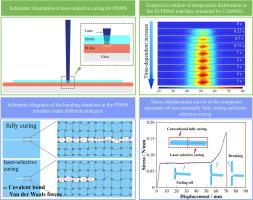激光选择性固化增强3d打印聚二甲基硅氧烷基结构的层间键合
IF 14.3
1区 材料科学
Q1 MATERIALS SCIENCE, MULTIDISCIPLINARY
引用次数: 0
摘要
聚二甲基硅氧烷(PDMS)以其卓越的可拉伸性和生物相容性而闻名,已被广泛用作可穿戴和可拉伸电子产品的柔性衬底。然而,由于层间结合强度不足导致的3d打印PDMS结构的功能失效严重限制了其应用。为了解决这一挑战,本研究创新地提出了一种基于光热转换的选择性PDMS固化制造方法,其中聚酰亚胺(PI)薄膜作为中间导热介质引入,以实现高透明PDMS的选择性激光加热和局部固化。该策略不仅通过激光选择性固化PDMS为功能层提供结构支持,而且保留了大量未固化区域,使相邻PDMS层之间能够进行共价交联,从而有效提高层间键合强度。此外,激光固化区域被封装在这些未固化部分中,进一步增强了基于pdm的3d打印器件的层间键合强度。结果表明,与传统的完全固化逐层打印方法相比,该策略制备的样品在t剥离测试中出现了粘结失效,而拉脱测试显示界面结合强度至少提高了2.36倍,光学显微镜观察显示界面没有分层。利用该方法,成功制备了具有1000次循环稳定性能的柔性应变传感器和能够承受1000 μL/min流量而不泄漏的微流控芯片。本文章由计算机程序翻译,如有差异,请以英文原文为准。

Laser-selective curing for enhancement of interlayer bonding of 3D-printing polydimethylsiloxane-based structures
Polydimethylsiloxane (PDMS), renowned for its exceptional stretchability and biocompatibility, has been extensively employed as a flexible substrate for wearable and stretchable electronics. However, the functional failure of 3D-printed PDMS structures caused by insufficient interlayer bonding strength significantly limits their applications. To address this challenge, this study innovatively proposes a manufacturing method for selective PDMS curing based on photothermal conversion, in which polyimide (PI) film is introduced as an intermediate thermally conductive medium to enable selective laser heating and localized curing of highly transparent PDMS. This strategy not only provides structural support for functional layers via laser-selective curing of PDMS but also retains substantial uncured regions to enable covalent crosslinking between adjacent PDMS layers, thereby effectively improving the interlayer bonding strength. Moreover, the laser-cured zones are encapsulated within these uncured portions, further achieving the enhancement of interlayer bonding strength of PDMS-based 3D-printed devices. The results demonstrate that compared with conventional fully curing layer-by-layer printing approaches, the samples prepared by this strategy exhibited cohesive failure during the T-peel test, while pull-off testing demonstrated a minimum 2.36-fold enhancement in interfacial bonding strength, and optical microscopy observations at 20× magnification revealed no delamination at the interfaces. Leveraging this method, a flexible strain sensor with stable performance over 1,000 cycles and a microfluidic chip capable of withstanding a flow rate of 1000 μL/min without leakage were successfully fabricated.
求助全文
通过发布文献求助,成功后即可免费获取论文全文。
去求助
来源期刊

Journal of Materials Science & Technology
工程技术-材料科学:综合
CiteScore
20.00
自引率
11.00%
发文量
995
审稿时长
13 days
期刊介绍:
Journal of Materials Science & Technology strives to promote global collaboration in the field of materials science and technology. It primarily publishes original research papers, invited review articles, letters, research notes, and summaries of scientific achievements. The journal covers a wide range of materials science and technology topics, including metallic materials, inorganic nonmetallic materials, and composite materials.
 求助内容:
求助内容: 应助结果提醒方式:
应助结果提醒方式:


